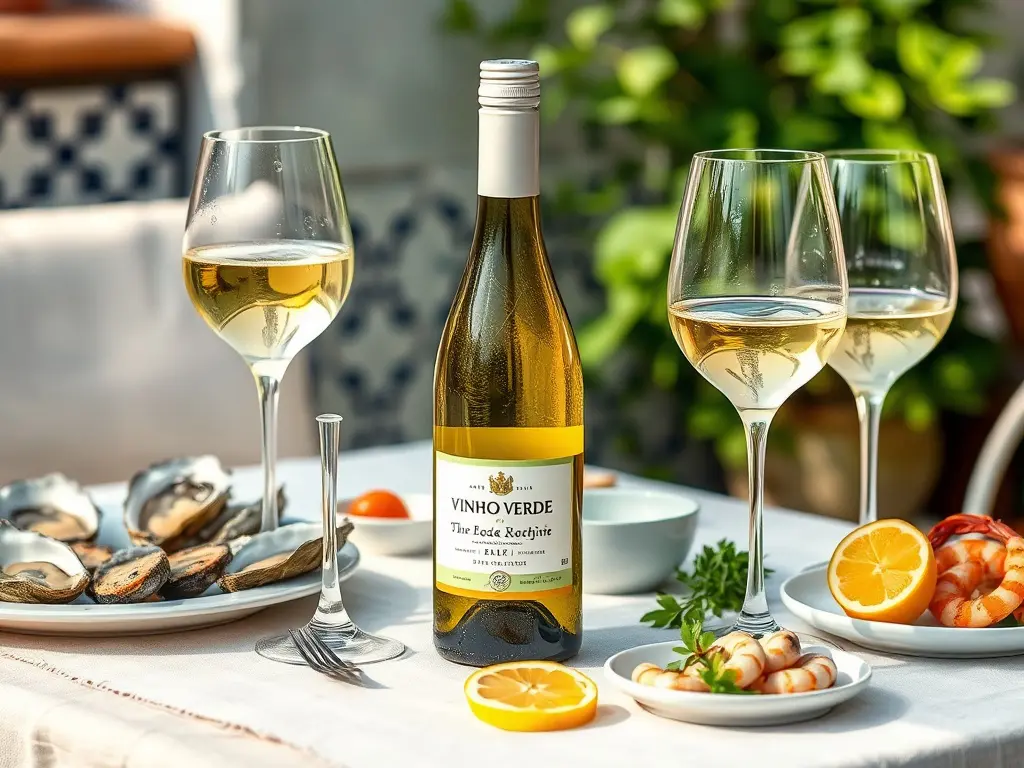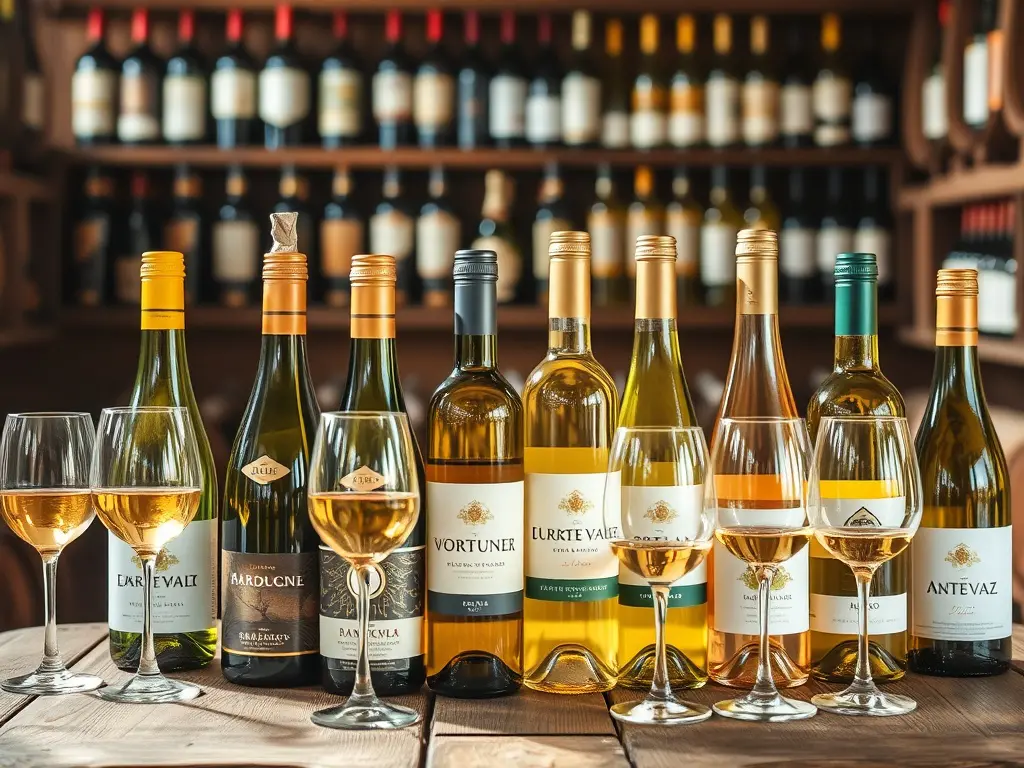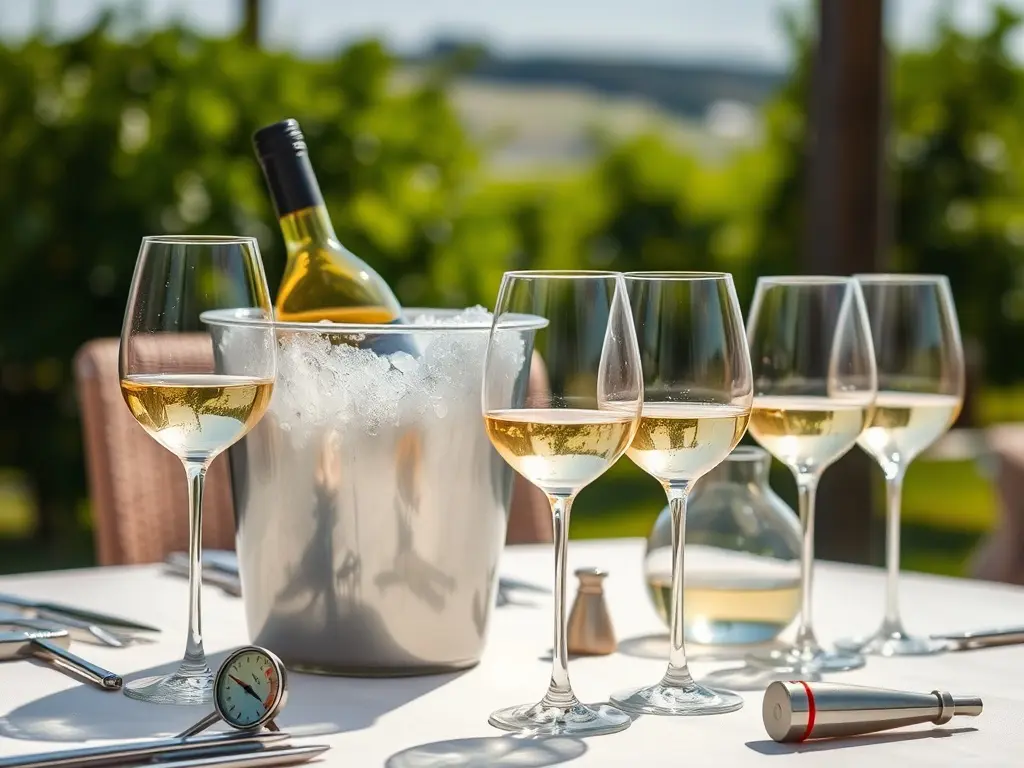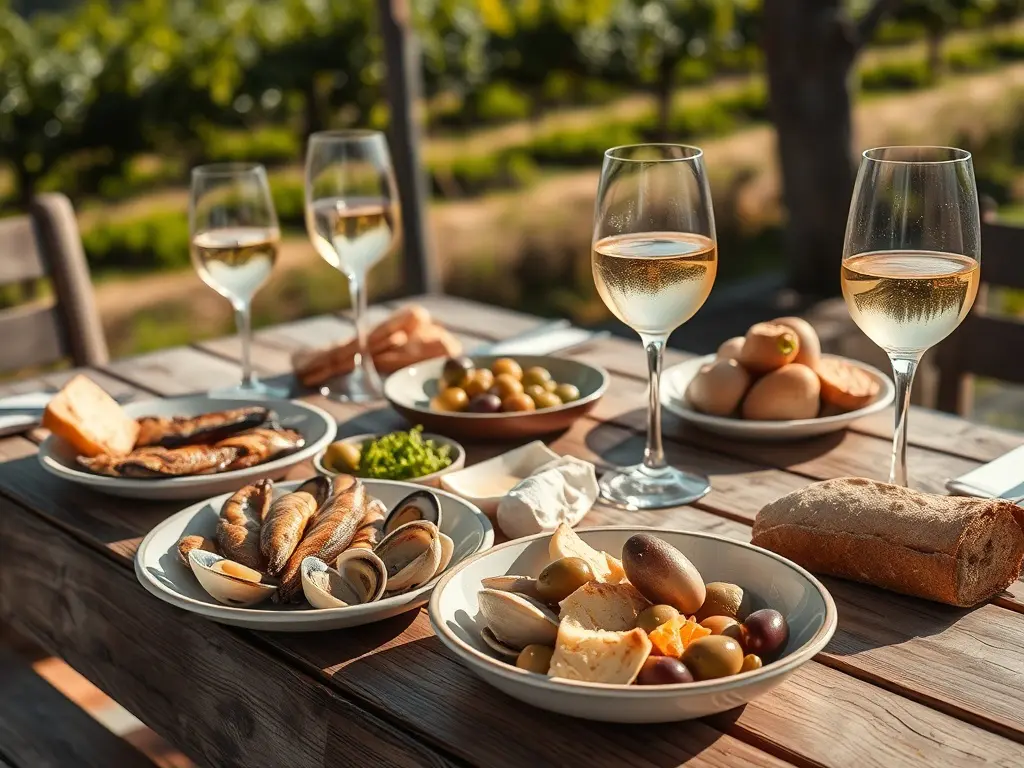This post may contains affiliate links. Read our full disclosure here.
Portuguese White Wines have completely changed my perception of what white wine can be. After years of sipping the same Chardonnays and Sauvignon Blancs, discovering Portugal’s vibrant whites was like finding a secret door to a whole new wine world. From the gentle fizz of Vinho Verde to the sophisticated complexity of Dão’s Encruzado, Portuguese White Wines offer an incredible range of styles that deserve much more recognition.

What makes these wines so special is their commitment to indigenous grape varieties that you simply can’t find elsewhere. Unlike many wine regions that plant international varieties, Portugal proudly showcases its native grapes, creating wines with distinctive personalities and a true sense of place. Whether you’re a casual sipper or a dedicated wine enthusiast, Portuguese White Wines provide exceptional value and endless exploration possibilities.
Vinho Verde: The Gateway to Portuguese White Wines

My first experience with Portuguese White Wines came through a bottle of Vinho Verde that a friend brought to a summer picnic. That slight effervescence and bright acidity was exactly what I needed on a hot day! Vinho Verde, which translates to “green wine,” refers not to the color but to its youth and freshness. These wines come from Portugal’s cool, rainy northwest region where the Atlantic influence creates perfect conditions for crisp, aromatic whites.
“Portuguese White Wines blend history, sunshine, and innovation in every glass.”
What Defines Vinho Verde
- Region: Cool, Atlantic-influenced northwest Portugal, where lush vegetation thrives.
- Style: Typically low in alcohol (8-11%), slightly effervescent, and extremely refreshing.
- Grapes: Alvarinho, Loureiro, and Arinto take center stage in most blends.
- Character: Vibrant acidity with a subtle spritz that makes these wines incredibly drinkable.
Flavor & Food Pairings
- Tasting Notes: Lemon, lime, green apple, with floral and mineral undertones.
- Perfect Match For: Ceviche, oysters, grilled prawns, and sushi.
- Serving Tip: Serve at 45–50°F to highlight its crisp and vibrant palate.
- My Go-To Pairing: A simple plate of fresh sardines with lemon and herbs – heavenly!
The beauty of Vinho Verde is its versatility and approachability. Even friends who claim they “don’t like white wine” often change their tune after trying a well-chilled glass on a warm evening. For those just beginning to explore what to eat with white wine, Vinho Verde is a forgiving partner that works with almost any light, fresh dish.
Beyond Vinho Verde: Other Standout Portuguese White Wines

While Vinho Verde might be the poster child for Portuguese White Wines, the country’s white wine portfolio goes far beyond these refreshing sippers. From sun-drenched plains to volcanic islands, Portugal offers an impressive diversity of white wine styles that showcase the country’s varied terroir. Each region brings something unique to the glass, making Portuguese whites some of the most exciting wines to explore.
Alentejo Whites
- Climate: Warm and dry, producing more full-bodied and fruit-forward profiles.
- Grapes: Features Antão Vaz, Arinto, Roupeiro.
- Style: Richly textured with tropical fruit, melon, honeyed citrus, and balanced acidity.
- Pairing Tip: Serve with tapas, paella, or roast pork to complement the fuller frame.
The Alentejo region reminds me of a Portuguese version of California – hot, sunny, and capable of producing whites with generous fruit character. These wines offer fantastic value compared to similarly styled wines from more famous regions. Understanding what is terroir in wine really helps appreciate how Alentejo’s climate shapes these luscious whites.
Dão Whites
- Elevation Advantage: Cooler nights bring elegance and clean acidity.
- Star Grape: Encruzado – structured and aromatic, with ability to develop in bottle.
- Tasting Profile: Peaches, citrus peel, almonds, soft vanilla, creamy texture thanks to oak aging in some styles.
- Perfect Pairing: Roast chicken, creamy risotto, or mild sheep cheeses.
Bairrada & Lisboa Regions
- Bairrada: Bracing acidity with a sea-breeze finish, often unoaked.
- Lisboa: Long maritime coastline gives freshness and layered minerality.
- Key Grapes: Fernão Pires and Arinto dominate both regions.
- When to Open: Best for grilled sardines, salty cheeses, and Mediterranean mezze.
Azores Island Whites
- Volcanic Influence: Stony soils lend salinity and electric minerality.
- Grape Standouts: Arinto dos Açores and Verdelho.
- Taste Notes: Smoky mineral, sea spray, green mango, and passionfruit.
- Serve With: Octopus salad, grilled sea bass, or tangy goat cheese.
The Azores wines might be the most fascinating of all Portuguese White Wines. Grown on volcanic islands in the middle of the Atlantic, these whites have an intense mineral quality that’s impossible to replicate. They’re harder to find but worth seeking out for a truly unique wine experience.
Understanding Portuguese Grape Varieties

Getting to know the native grapes is key to understanding what makes Portuguese White Wines so special. Unlike the international varieties that dominate many wine regions, Portugal’s indigenous grapes offer flavors you simply can’t find elsewhere. These varieties have adapted to local conditions over centuries, resulting in wines that truly express their origin.

Alvarinho
- Character: Fresh, floral, and citrus-driven with peach and apricot hints.
- Where It Grows: Predominantly in Vinho Verde’s Monção e Melgaço sub-region.
- Pairs With: Seafood—oysters, clams, and shrimp cocktail especially.
- Fun Fact: Known as Albariño just across the border in Spain’s Rías Baixas region.
Alvarinho makes some of the most sophisticated wines in the Vinho Verde region. Unlike the lighter blends, single-varietal Alvarinho can be quite serious, with amazing depth and even aging potential. These wines demonstrate that quality wine full living doesn’t always mean turning to the famous regions of France or Italy.
Arinto
- Profile: Clean lemon-lime zip with strong acidity.
- Top Regions: Bucelas, Lisboa, and Alentejo.
- Serve Alongside: Grilled octopus, smoked fish, or summer salads.
- Key Attribute: Maintains acidity even in warm climates, making it valuable throughout Portugal.
Encruzado
- Why It Shines: Age-worthy, elegant, and frequently compared to fine white Burgundy.
- Next Glass: Look in Dão or Beira Alta appellations.
- Pairing Perfection: Creamy dishes like chicken in mushroom sauce or truffle pasta.
- Investment Potential: Quality Encruzado can develop beautifully for 5-10+ years.
Encruzado might be Portugal’s best-kept white wine secret. When I first tried an oak-aged version, I was convinced it was a premium Chardonnay until my friend revealed the bottle. These wines can be truly world-class and offer tremendous value compared to white Burgundy or other premium whites. For excellent food and wine pairing fundamentals, Encruzado is an excellent study.
The Modern Portuguese White Wine Movement

There’s a revolution happening in the Portuguese White Wines scene. A new generation of winemakers is combining centuries of tradition with modern techniques, creating wines that honor their heritage while appealing to contemporary palates. This blend of old and new is resulting in some of the most exciting white wines on the market today.
What’s Happening in 2025
- Sustainability Focus: Many vineyards are shifting to organic or biodynamic cultivation.
- Winemaker Philosophy: Young enologists are championing native grapes, lower intervention, and regional identity.
- Emergent Trends: Skin-contact whites, orange wines, and amphora-aged bottlings.
- On the World Stage: Portuguese White Wines are racking up medals in international competitions—proving their value and quality.
One thing I’ve noticed is how many Portuguese producers are embracing organic vs biodynamic wine practices. This commitment to sustainability isn’t just good for the environment—it’s often resulting in more expressive, character-driven wines that better reflect their terroir.
The wine world is finally starting to take notice. Portuguese whites are appearing on more restaurant wine lists and gaining recognition from critics who previously overlooked this diverse wine nation. For savvy wine lovers, this means now is the perfect time to explore these wines before prices catch up to their quality.
Serving Tips for Portuguese White Wines

Getting the most from your Portuguese White Wines means paying attention to a few serving details. Temperature and glassware might seem like minor concerns, but they can dramatically impact how these wines present themselves. With just a little attention to these details, you’ll maximize your enjoyment of these distinctive wines.
- Temperature Tips:
- Vinho Verde & light wines: 45–50°F.
- Encruzado, fuller whites: 55°F.
- Glass Matters: Use tulip-shaped or medium white wine glasses to preserve fragrance.
- Storage: Store upright in a cool, dark, and humidity-controlled spot.
- Decanting: Fuller whites like Encruzado can benefit from 15-20 minutes in a decanter.
I’ve found that serving temperature makes a huge difference with Portuguese White Wines. Too cold, and you’ll miss the nuanced aromatics of something like an aged Encruzado. Too warm, and a Vinho Verde loses its refreshing zip. When in doubt, start cooler—you can always let the wine warm up in the glass, but you can’t cool it down as easily.
Food Pairings to Try

One of the greatest strengths of Portuguese White Wines is their food-friendliness. From the lightest seafood dishes to surprisingly robust poultry and pork preparations, these versatile whites can handle a wide range of cuisines. Here are some pairings that showcase what makes these wines special:
| Dish Type | Recommended Region | Grape Variety | Why It Works |
|---|---|---|---|
| Grilled sardines | Lisboa | Arinto | Invigorating acidity balances oiliness |
| Fresh oysters | Vinho Verde | Alvarinho | Minerality matches briny shellfish |
| Roast chicken | Dão | Encruzado | Texture and richness align beautifully |
| Tapas & cheese | Alentejo | Antão Vaz | Fruity and round to refresh the palate |
After hosting several Portuguese wine dinners, I’ve found that Portuguese White Wines particularly shine with seafood dishes that have a bit of richness. A garlicky shrimp with olive oil, or bacalhau (salt cod) preparations match wonderfully with the natural acidity and mineral qualities these wines offer. For more inspiration on perfect matches, check out guides on what to eat with white wine.
FAQs About Portuguese White Wines
When introducing friends to Portuguese White Wines, I often get asked these common questions:
Are Portuguese white wines always light?
No. While some styles, like Vinho Verde, are bright and easy-drinking, others, such as Encruzado or Antão Vaz, can be full-bodied and structured. Portugal offers a tremendous range of white wine styles from featherweight to substantial.
Is Vinho Verde always fizzy?
Traditionally, yes. But modern versions range from lightly pétillant to completely still, with higher-end bottlings often showing no effervescence at all. The slight fizz in traditional Vinho Verde comes from a small amount of malolactic fermentation happening in the bottle.
Can Portuguese whites age well?
Absolutely. Wines made from Encruzado, Arinto, and even Antão Vaz develop beautifully with a few years of bottle age. Premium examples can evolve for 5-10+ years, developing honey, nut, and complex mineral notes while maintaining freshness.
What’s the best temperature to serve them?
Anywhere from 45–55°F depending on the grape and body style. Lighter wines like Vinho Verde show best colder (45-48°F), while fuller-bodied whites like Encruzado benefit from slightly warmer serving temperatures (52-55°F).
Why These Wines Should Be On Your Radar

Portuguese White Wines offer something truly special in today’s wine world – authenticity, distinctiveness, and exceptional value. When I think about what makes these wines worth seeking out, it comes down to their ability to deliver genuine character without the price tag of more famous regions.
From the refreshing simplicity of a basic Vinho Verde to the sophisticated complexity of a premium Dão Encruzado, Portugal delivers whites for every occasion and budget. These wines reflect centuries of winemaking tradition while embracing modern quality standards.
What I love most is how these wines remain true to their roots, championing indigenous varieties instead of planting international grapes. This commitment to authenticity means you’re tasting something you can’t find elsewhere – a true reflection of Portugal’s diverse landscapes and winemaking heritage.
Next time you’re browsing the wine shop looking for something new, reach for a Portuguese White Wine. Whether you’re planning a casual gathering or a special dinner, these wines deliver remarkable quality, versatility, and a taste of Portugal’s rich wine culture. Your palate (and wallet) will thank you for the adventure. For more wine exploration ideas and pairing suggestions, visit Wine Full Living.




